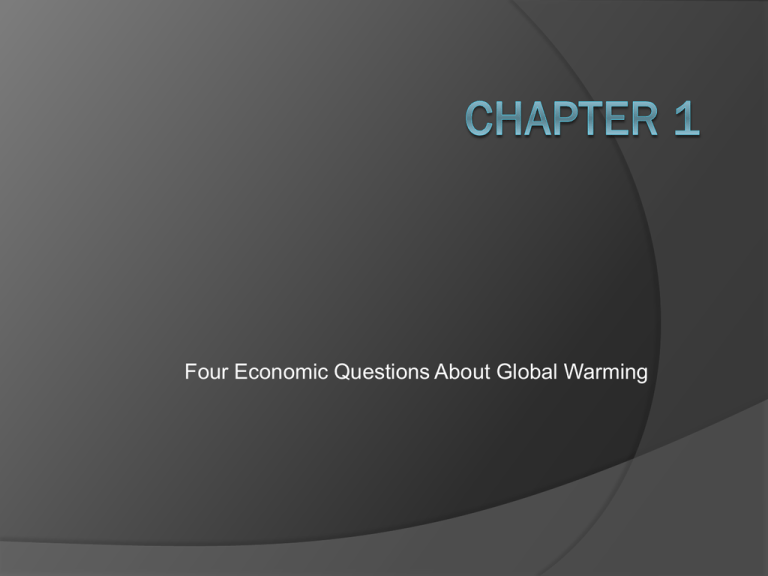Emission Reduction Profile to achieve 450 PPM
advertisement

Four Economic Questions About Global Warming The Four Economic Questions 1. How Much Pollution is too Much? 2. Is Government Up to the Job? 3. How Can We Do Better? 4. Can We Resolve Global Issues Introduction Global Warming Arises from the accumulation of greenhouses gases (e.g. carbon dioxide) and the resulting “carbon blanket” warms the earth Poses a potentially severe threat to human welfare and natural ecosystems A Hotter Planet 2010 on track to be the hottest year on record. Potential Consequences of Global Warming Reductions in agricultural output due to changing temperature & rainfall Major changes in natural ecosystems Higher disease rates Accelerated species extinction Sea Level Rise-- +1 m by 2100 A warming of more than 4 degrees F increases the probability of catastrophic outcomes “How far can it go? The last time the world was three degrees warmer than today – which is what we expect later this century – sea levels were 25m higher. So that is what we can look forward to if we don't act soon…I think sea-level rise is going to be the big issue soon, more even than warming itself… How long have we got? We have to stabilize emissions of carbon dioxide within a decade, or temperatures will warm by more than one degree. That will be warmer than it has been for half a million years, and many things could become unstoppable.…We don't have much time left.” Dr. James Hansen, Director, NASA Goddard Institute for Space Studies. – The Independent 2/ 17/2006 Growing Concern Global Warming Scientists agree that global warming is already a reality The magnitude of this warming will largely depend on positive and negative feedback effects (acceleration and deceleration of warming, respectively) How hot will it get? Atmospheric CO2 levels in 1880: 280ppm. Now: +390 ppm. Global temperature rise since 1880: more than 1.5 degree F. 2100: +2.5 to + 10.5 degrees F. Last Ice Age: Avg. global temp ~ 9 degrees F colder than today. 1. How Much is Too Much? The efficiency standard relies on formal benefit-cost analysis The safety standard requires reducing pollution to “safe” levels, unless the costs of doing so are prohibitive The ecological sustainability standard requires protecting natural ecosystems from major changes, unless the costs of doing so are prohibitive How Much Pollution is too Much? Global Warming Kyoto global warming treaty requires participating countries to reduce greenhouse emissions to below 1990 levels by 2010. It is based on a safety/sustainability goal of preventing dangerous interference with the climate. How Much Pollution is too Much? Global Warming One application of the efficiency approach, based on formal benefit-cost analysis of global warming calls, for cuts of 10% below the business-as-usual baseline. This is less stringent than Kyoto. An Ethical Debate The debate over which standard is “right” depends on how society chooses to both measure and weigh the costs and benefits of pollution reduction and resource protection 2. Is Government Up to the Job? Government action is necessary to reduce pollution in a market economy Two obstacles to effective government intervention Imperfect information Opportunity for political influence The Conservative View Traditional conservatives view governmental intervention as a necessary evil and argue for a limited government role. They believe government actors primarily serve special interests The Progressive View Progressives believe government can promote an activist agenda to serve the general interest of the public They believe government failures result from unequal distributions of wealth and power in society. The Role of Economics Economists try to objectively assess the costs and benefits of cleaning up the environment and protecting resources, and to make recommendations to achieve social goals as cost-effectively as possible. 3. How Can We Do Better? Today, the current method of environmental protection is commandand-control regulation Government mandates the adoption of certain abatement technologies Widely criticized as centralized and inflexible, and more costly than necessary Incentive-Based Regulation Incentive-based regulation approaches set emission reduction targets and leave it to industry to decide how best to comply The government provides firms with incentives to reduce emissions (e.g. a tax on pollution, or a cap-and-trade system) Promotion of Clean Technologies Government can also directly promote the adoption of clean technologies through Research and development funding Infrastructure investment Efficiency Standards Technical Assistance 4. Can We Resolve Global Issues? Reducing global poverty Slowing population growth Halting unsustainable exploitation of natural resources Developing effective international agreements Global Issues? Global Warming Agreements like Kyoto face two major obstacles: They are “public goods” and face incentives for “free-riding” : US & Australia are major polluters, and non-participants. Poor countries cannot afford emission reductions: developing countries are not participants. Emission Reduction Profile to achieve 450 PPM The Kyoto solution: Marketable Permits Promoted by US Economists during the Clinton Administration Caps rich country emissions; provides incentives to develop clean technologies Funds the transfer of technology to poor countries Europeans have successfully implemented cap-and-trade as part of their strategy to reach the Kyoto targets On to Part 1: How Much Pollution is Too Much?





